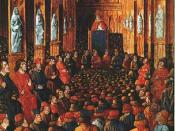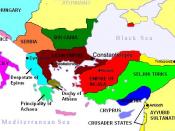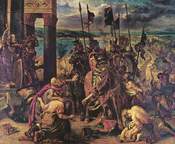After the death of Charlemagne, king of the Franks, in 814 and the following collapse of his empire, Christian Europe was under attack and on the defensive." The Magyars, nomadic people from Asia, ravaged eastern and central Europe until the 10th century". Around 800, several centuries of Viking raids disrupted life in northern Europe and even threatened Mediterranean cities. Nevertheless, the greatest threat came from the forces of Islam, very militant and victorious in the centuries following the death of their leader, Muhammad, in 632. By the eighth century Islamic forces had conquered North Africa, the eastern shores of the Mediterranean, and most of Spain. Islamic armies established bases in Italy, greatly reduced the size of the Byzantine Empire, and besieged the capital, Constantinople. In the 11th century the balance of power began to swing toward the West. For the first time in many years, the popes were able to effectively unite European popular support behind them, a factor that contributed greatly to the popular appeal to the first Crusades.
Moreover, Europe's population was growing, its urban life was beginning to revive, and both long distance and local trade were gradually increasing. European human and economic resources could now support new ventures on the scale of the Crusades. The crusades were military expeditions launched against the Muslims by the Christians in an attempt to regain the Holy Land. They took place between 1095 A.D. and 1270 A.D. It was one of the most violent periods in the history of mankind.
The starting point of the crusades was on November 18, 1095 A.D. when Pope Urban II opened the Council of Clermont. On November 27, outside the French city of Clermont-Ferrand, the Pope made an important speech . "He called upon everyone to help the Christians in the east to restore...



Well done, a really good paper for your level.
That you titled this "Crusades in Europe and how it effected everyone during their time" you really should have paid more attention to the effects of the crusades. In both the west and the middle east.
As for the effects of the crusades in Europe things that would have given the analysis more depth would be stuff like English attitudes towards a king (Richard) who spent more time warring then at home ruling and who taxed heavily to support the third crusade.
Also a topics you might like to look at in the future would be the 12th century renaissance (see. the 12th century renaissance by Charles Homer Haskins) and the black death. More so the 12 cent. ren. because the crusades contributed to this in part.
You fail to mention that the Albigensians were Christian heretics, a quote noted from the time (by Christian crusaders, note not an exact quote) "kill them all [Catholics and Heretics] God will sort the sinners out" a good source on the albigensians is Jacques Madaule.
You fail to note that Frederick II was more or less forced to take the vi crusade and that after being excommunicated he decided to have himself crowned king of Jerusalem.
The viii crusade should have been included (I believe).
1 out of 1 people found this comment useful.